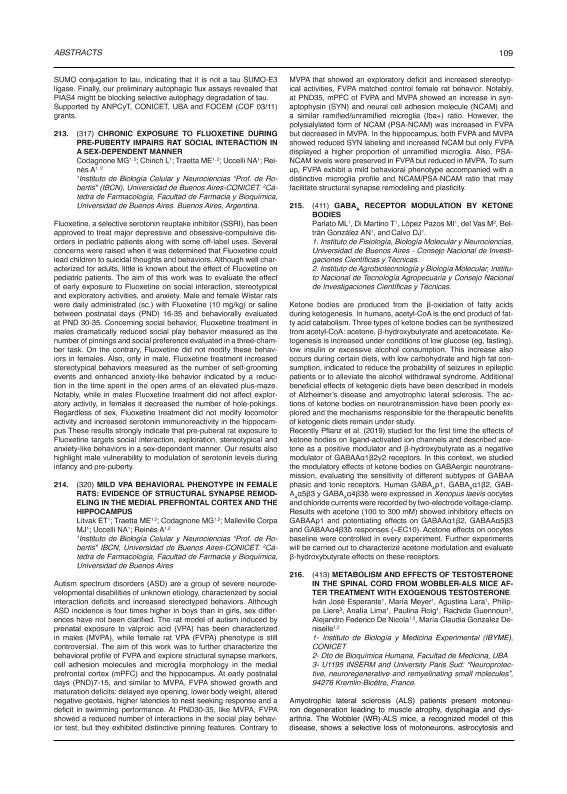Evento
Mild VPA behavioral phenotype in female rats: Evidence of structural synapse remodeling in the medial prefrontal cortex and the hippocampus
Litvak, Einav Tamara; Traetta, Marianela Evelyn ; Codagnone, Martín Gabriel
; Codagnone, Martín Gabriel ; Malleville Corpa, María José; Uccelli, Nonthué Alejandra
; Malleville Corpa, María José; Uccelli, Nonthué Alejandra ; Reines, Analia Gabriela
; Reines, Analia Gabriela
 ; Codagnone, Martín Gabriel
; Codagnone, Martín Gabriel ; Malleville Corpa, María José; Uccelli, Nonthué Alejandra
; Malleville Corpa, María José; Uccelli, Nonthué Alejandra ; Reines, Analia Gabriela
; Reines, Analia Gabriela
Tipo del evento:
Reunión
Nombre del evento:
LXV Reunión Anual de la Sociedad Argentina de Investigación Clínica; LXVIII Reunión Anual de la Sociedad Argentina de Inmunología y Reunión Anual de la Sociedad Argentina de Fisiología.
Fecha del evento:
10/11/2020
Institución Organizadora:
Sociedad Argentina de Investigación Clínica;
Sociedad Argentina de Inmunología;
Sociedad Argentina de Fisiología;
Título de la revista:
Medicina (Buenos Aires)
Editorial:
Fundación Revista Medicina
Idioma:
Inglés
Clasificación temática:
Resumen
Autism spectrum disorders (ASD) are a group of severe neurodevelopmental disabilities of unknown etiology, characterized by social interaction deficits and increased stereotyped behaviors. Although ASD incidence is four times higher in boys than in girls, sex differences have not been clarified. The rat model of autism induced by prenatal exposure to valproic acid (VPA) has been characterized in males (MVPA), while female rat VPA (FVPA) phenotype is still controversial. The aim of this work was to further characterize the behavioral profile of FVPA and explore structural synapse markers, cell adhesion molecules and microglia morphology in the medial prefrontal cortex (mPFC) and the hippocampus. At early postnatal days (PND)7-15, and similar to MVPA, FVPA showed growth and maturation deficits: delayed eye opening, lower body weight, altered negative geotaxis, higher latencies to nest seeking response and a deficit in swimming performance. At PND30-35, like MVPA, FVPA showed a reduced number of interactions in the social play behavior test, but they exhibited distinctive pinning features. Contrary to MVPA that showed an exploratory deficit and increased stereotypical activities, FVPA matched control female rat behavior. Notably, at PND35, mPFC of FVPA and MVPA showed an increase in synaptophysin (SYN) and neural cell adhesion molecule (NCAM) and a similar ramified/unramified microglia (Iba+) ratio. However, the polysialylated form of NCAM (PSA-NCAM) was increased in FVPA but decreased in MVPA. In the hippocampus, both FVPA and MVPA showed reduced SYN labeling and increased NCAM but only FVPA displayed a higher proportion of unramified microglia. Also, PSA-NCAM levels were preserved in FVPA but reduced in MVPA. To sum up, FVPA exhibit a mild behavioral phenotype accompanied with a distinctive microglia profile and NCAM/PSA-NCAM ratio that may facilitate structural synapse remodeling and plasticity.
Palabras clave:
AUTISM
,
SOCIAL BEHAVIOR
,
ADHESION MOLECULES
,
SEXUAL DIFFERENCES
Archivos asociados
Licencia
Identificadores
Colecciones
Eventos(IBCN)
Eventos de INST.DE BIOLO.CEL.Y NEURCS."PROF.E.DE ROBERTIS"
Eventos de INST.DE BIOLO.CEL.Y NEURCS."PROF.E.DE ROBERTIS"
Citación
Mild VPA behavioral phenotype in female rats: Evidence of structural synapse remodeling in the medial prefrontal cortex and the hippocampus; LXV Reunión Anual de la Sociedad Argentina de Investigación Clínica; LXVIII Reunión Anual de la Sociedad Argentina de Inmunología y Reunión Anual de la Sociedad Argentina de Fisiología.; Virtual; Argentina; 2020; 109-109
Compartir



